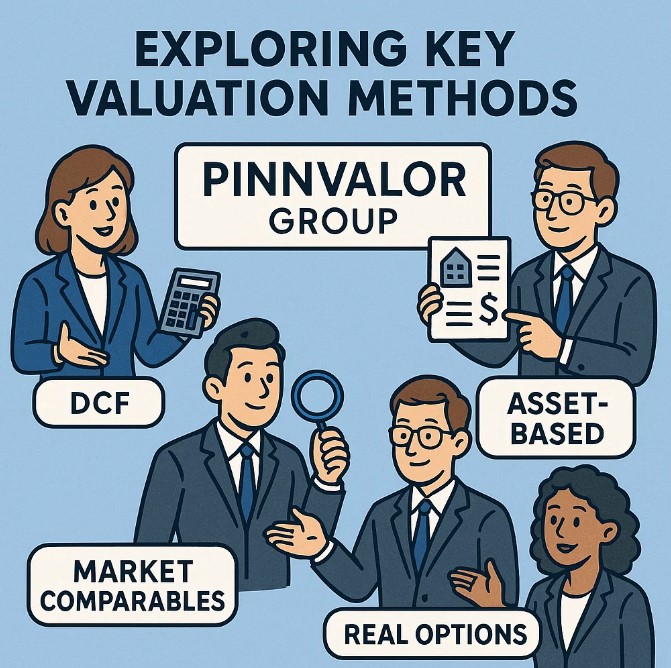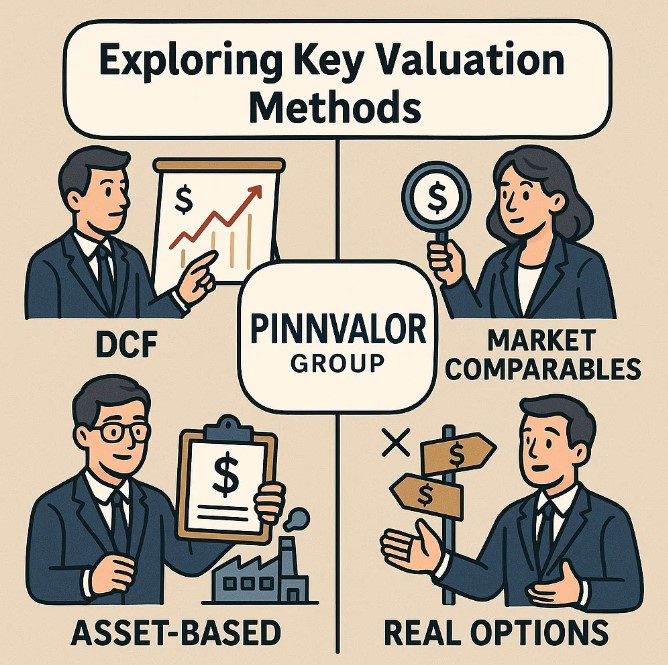
Exploring Key Valuation Methods: DCF, Market Comparables, Asset-Based, and Real Options
Valuation is a critical process in finance, investment, and strategic decision-making. Whether you're assessing a potential acquisition, pricing a startup, or evaluating an investment opportunity, selecting the right valuation method is essential. Each valuation method offers unique insights and is suited for specific contexts. In this post, we’ll explore four of the most widely used valuation approaches: Discounted Cash Flow (DCF), Market Comparables, Asset-Based Valuation, and Real Options.
Are you using the right valuation approach to unlock your business’s true potential?
From cash flows to comparables, assets to options—each valuation method offers a unique lens. The key is knowing when and how to use them.
1. Discounted Cash Flow (DCF) Method
What It Is:
The Discounted Cash Flow (DCF) method estimates the intrinsic value of a business or asset by forecasting its expected future cash flows and discounting them to their present value using an appropriate discount rate (often the cost of capital).
Key Components:
- Projected Cash Flows: Typically over 5–10 years.
- Terminal Value: The value of the business beyond the forecast period.
- Discount Rate: Reflects the risk of the investment (usually WACC – Weighted Average Cost of Capital).
When to Use:
- When the business has stable and predictable cash flows.
- For mature companies or infrastructure projects.
- In investment banking, corporate finance, and equity research.
Advantages:
- Focuses on intrinsic value.
- Customizable to business-specific risks and growth potential.
Limitations:
- Highly sensitive to assumptions (growth rate, discount rate).
- Requires detailed financial projections.
2. Market Comparables (Relative Valuation)
What It Is:
Also known as the market approach, this method involves comparing the target company to similar businesses (peers) that are publicly traded or have been recently acquired. Valuation multiples such as EV/EBITDA, P/E, or EV/Sales are commonly used.
Key Components:
- Selection of Comparable Companies or Transactions
- Standardized Financial Metrics
- Application of Multiples to the Target Company’s Financials
When to Use:
- When there’s access to reliable market data.
- For industries with many comparable firms (e.g., tech, retail, manufacturing).
Advantages:
- Market-driven and relatively simple.
- Reflects current investor sentiment and pricing trends.
Limitations:
- May not capture firm-specific factors.
- Difficult to find truly comparable companies, especially for startups or unique business models.
3. Asset-Based Valuation
What It Is:
The Asset-Based approach determines the value of a company by summing the value of its individual assets and subtracting liabilities. It’s based on the balance sheet rather than earnings or cash flows.
Variants:
- Book Value Method
- Liquidation Value Method
- Adjusted Net Asset Method
When to Use:
- For asset-heavy businesses (e.g., real estate, manufacturing).
- In liquidation scenarios or distressed situations.
- When cash flows are unreliable or unavailable.
Advantages:
- Grounded in tangible data.
- Useful in insolvency or restructuring cases.
Limitations:
- Ignores future earning potential.
- May undervalue intangible assets (e.g., brand, goodwill, intellectual property).

4. Real Options Valuation (ROV)
What It Is:
The Real Options approach applies financial option theory to real-world investment decisions. It values the flexibility a business has to adapt its strategy in response to market developments (e.g., expand, delay, abandon a project).
Key Types of Real Options:
- Growth Options
- Abandonment Options
- Timing Options
- Switching Options
When to Use:
- For R&D-intensive industries (e.g., biotech, energy, technology).
- When future investment decisions are contingent on uncertain outcomes.
- To value startups and early-stage projects with high uncertainty.
Advantages:
- Captures strategic flexibility and managerial decision-making.
- Accounts for the value of uncertainty and optionality.
Limitations:
- Complex and data-intensive.
- Requires specialized modeling (e.g., binomial trees, Black-Scholes).
Choosing the Right Approach
Each valuation method has its strengths and ideal applications:
| Method | Best For | Focus |
|---|---|---|
| DCF | Predictable cash flow businesses | Intrinsic value |
| Market Comparables | Public or easily benchmarked companies | Market sentiment |
| Asset-Based | Asset-heavy or distressed firms | Net asset value |
| Real Options | High-uncertainty, strategic investment projects | Flexibility value |
Often, professionals use a combination of these methods (called the triangulation approach) to validate results and improve confidence in the valuation.
Conclusion
Understanding and applying the right valuation approach is crucial for accurate financial decision-making. While DCF is widely regarded as the gold standard for intrinsic valuation, the market comparables method provides valuable real-world pricing context. Asset-based valuation offers a grounded baseline, and real options add strategic depth where uncertainty reigns.
By mastering these valuation methods, investors, entrepreneurs, and financial professionals can make more informed, confident, and value-driven decisions.
